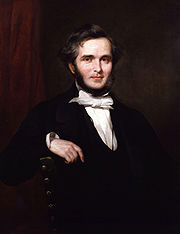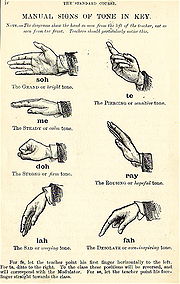
John Curwen
Encyclopedia

Congregational church
Congregational churches are Protestant Christian churches practicing Congregationalist church governance, in which each congregation independently and autonomously runs its own affairs....
minister, and founder of the Tonic sol-fa
Tonic sol-fa
Tonic sol-fa is a pedagogical technique for teaching sight-singing, invented by Sarah Ann Glover of Norwich, England and popularised by John Curwen who adapted it from a number of earlier musical systems...
system of music education
Music education
Music education is a field of study associated with the teaching and learning of music. It touches on all domains of learning, including the psychomotor domain , the cognitive domain , and, in particular and significant ways,the affective domain, including music appreciation and sensitivity...
. He was educated at Wymondley College (subsequently Coward College) and University College London
University College London
University College London is a public research university located in London, United Kingdom and the oldest and largest constituent college of the federal University of London...
.
Tonic sol-fa
John Curwen was a descendent of the Curwens of Workington Hall in Cumbria, one of the oldest families in England, the male line proper being a direct descent from Eldred, a pre-Norman Englishman, whose son Ketel held lands in the Barony of Kendal. Orm, Ketel's son, inherited the Cumbrian manor of Workington.John Curwen was born November 14, 1816 at Heckmondwike
Heckmondwike
Heckmondwike is a small town in the metropolitan borough of Kirklees, which is located geographically at the centre of West Yorkshire, England, south west of Leeds. Close to Cleckheaton and Liversedge, it is part of Cleckheckmondsedge, a name invented by J.B. Priestley to represent a West Riding...
, West Yorkshire, the son of Spedding Curwen and Mary Jubb. His father was a Non-conformist minister, as John was also from 1838 until 1864. Curwen gave up full time ministry in order to devote himself to his new method of musical nomenclature. Curwen's system was designed to aid in sight reading
Sight reading
Sight-reading is the reading and performing of a piece of written music, specifically when the performer has not seen it before. Sight-singing is often used to describe a singer who is sight-reading.-Sight-reading:...
of the stave
Stave
Stave can refer to:*Staff , a set of five horizontal lines and four spaces used in musical notation*Stave church, a Medieval wooden church with post and beam construction prevalent in Norway*The individual wood strips that form the sides of a barrel...
with its lines and spaces. He adapted it from a number of earlier musical systems, including the Norwich Sol-fa method of Sarah Ann Glover
Sarah Ann Glover
Sarah Ann Glover was an English music educator who invented the Norwich sol-fa system.-Life and career:Glover was born in The Close, Norwich. Her father became Curate of St Laurence's Church, Norwich in 1811, and she developed her learning system to aid teachers with a cappella singing...
(1785–1867) of Norwich
Norwich
Norwich is a city in England. It is the regional administrative centre and county town of Norfolk. During the 11th century, Norwich was the largest city in England after London, and one of the most important places in the kingdom...
. Her Sol-fa system was based on the ancient gamut
Gamut (disambiguation)
Gamut may refer to:Arts and design:* Gamut, a complete scale in medieval music; see Guidonian hand, and Diatonic and chromatic* Gamut, a range of colors that can be reproduced by a particular printing process, display device, or set of paints...
; but she omitted the constant recital of the alphabetical names of each note and the arbitrary syllable indicating key relationship, and also the recital of two or more such syllables when the same note was common to as many keys (e.g. C, Fa, Ut, meaning that C is the subdominant
Subdominant
In music, the subdominant is the technical name for the fourth tonal degree of the diatonic scale. It is so called because it is the same distance "below" the tonic as the dominant is above the tonic - in other words, the tonic is the dominant of the subdominant. It is also the note immediately...
of G and the tonic
Tonic (music)
In music, the tonic is the first scale degree of the diatonic scale and the tonal center or final resolution tone. The triad formed on the tonic note, the tonic chord, is thus the most significant chord...
of C). The notes were represented by the initials of the seven syllables, still in use in Italy
Italy
Italy , officially the Italian Republic languages]] under the European Charter for Regional or Minority Languages. In each of these, Italy's official name is as follows:;;;;;;;;), is a unitary parliamentary republic in South-Central Europe. To the north it borders France, Switzerland, Austria and...
and France
France
The French Republic , The French Republic , The French Republic , (commonly known as France , is a unitary semi-presidential republic in Western Europe with several overseas territories and islands located on other continents and in the Indian, Pacific, and Atlantic oceans. Metropolitan France...
as their names. Curwen taught himself to sight-read based on Glover's Norwich Sol-fa, made alterations and improvements, and named his method Tonic Sol-fa. In the Tonic Sol-fa the seven letters refer to key relationship (relative pitch) and not to absolute pitch. Curwen utilized the first letter (lower case) of each of the solmization tones (do, re, me, fa, sol, la, ti), and a rhythmic system which used bar lines (prefixing strong beats), half bar lines (prefixing medium beats), and semicolons (prefixing weak beats) in each measure.

Sunday school
Sunday school is the generic name for many different types of religious education pursued on Sundays by various denominations.-England:The first Sunday school may have been opened in 1751 in St. Mary's Church, Nottingham. Another early start was made by Hannah Ball, a native of High Wycombe in...
teachers. Stemming from his religious and social beliefs, Curwen thought that music should be easily accessible to all classes and ages of people. Apart from Glover, similar ideas had been elaborated in France by Pierre Galin
Pierre Galin
Pierre Galin was a French music educator, and developer of what became the Galin-Paris-Chevé system.Galin studied mathematics and commerce, and became a mathematics teacher in Bourdeaux, at a school for children with speech and hearing difficulties...
(1786–1821), Aimé Paris
Aimé Paris
Aimé Paris was a French scholar. He was the developer of a method of stenography, and co-developer and propagator of what became the Galin-Paris-Chevé system of music notation.Paris studied mathematics and law, and became a lawyer...
(1798–1866) and Emile Chevé (1804–1864), whose method of teaching how to read at sight also depended on the principle of tonic relationship being taught by the reference of every sound to its tonic, and by the use of a numeric notation. Curwen adapted French time names from Paris' Langue de durées.
Curwen's publications
Curwen brought out his Grammar of Vocal Music in 1843, and in 1853 started the Tonic Sol-Fa Association. The Standard Course of Lessons on the Tonic Sol-fa Method of Teaching to Sing was published in 1858. In 1879 the Tonic Sol-Fa College was opened. Curwen also began publishing, and brought out a periodical called the Tonic Sol-fa Reporter and Magazine of Vocal Music for the People, and in his later life was occupied in directing the spreading organization of his system. With his son, John Spencer Curwen (1847–1916) who later became principal of the Tonic Sol-Fa College, Curwen incorporated the J. Curwen & Sons publishing firm in 1863. This firm continued as the Curwen Press into the 1970s, when it was closed. The Sol-fa system was widely adopted for use in education, as an easily teachable method in the reading of music at sight, but its more ambitious aims for providing a superior method of musical notation have not been generally adopted. In 1872, Curwen changed his former course of using the Sol-fa system as an aid to sight reading, when that edition of his Standard Course of Lessons excluded the staff and relied solely on Curwen's Tonic Sol-fa system.Curwen technically did not invent Tonic Sol-fa. Rather he developed a distinct method of applying it in music education, including both rhythm and pitch. The name and current form can be traced to Curwen.
Personal life
John Curwen married Mary Thompson (1816–1890) in May 1845. They had four children – Margaret, John Spencer, Spedding and Thomas Herbert. Curwen died at Heaton Mersey on May 16, 1887.Works
- A Tonic Sol-fa Primer
- The Teacher's Manual of the Tonic Sol-fa Method
- Grammar of Vocal Music
- Musical Theory
- Musical Statics
Memorial
Curwen is remembered in HeckmondwikeHeckmondwike
Heckmondwike is a small town in the metropolitan borough of Kirklees, which is located geographically at the centre of West Yorkshire, England, south west of Leeds. Close to Cleckheaton and Liversedge, it is part of Cleckheckmondsedge, a name invented by J.B. Priestley to represent a West Riding...
with a memorial in the Green Park and by Curwen Cresent, and in 2007 a new housing development in the north of the town was named Curwen Park.
Further reading
- Music and Victorian Philanthropy: The Tonic Sol-fa Movement by Charles Edward McGuire (Cambridge: Cambridge University Press, 2009)
- John Curwen: A Short Critical Biography, by Bernarr Rainbow (Sevenoaks: Novello, 1980)
- Song and Words: A History of the Curwen Press, by Herbert Simon (London: George Allen & Unwin Ltd., 1973)
External links
- The Boy's Voice; A Book of practical Information on The Training of Boys' Voices For Church Choirs, &c. (available in multiple formats at gutenberg.org]
- A History of the Tonic Sol-Fa System
- John Curwen & the Tonic Sol-fa method

